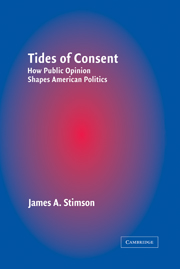Book contents
- Frontmatter
- Contents
- List of Tables and Figures
- Preface: The Shutdown
- Acknowledgments
- Tides of Consent
- 1 Opinion Flows
- 2 What the Public Wants from Government
- 3 Left and Right Movements in Preference
- 4 The Great Horse Race: Finding Meaning in Presidential Campaigns
- 5 Between the Campaigns: Public Approval and Disapproval of Government
- 6 On Politics at the Margin
- Bibliography
- Index
5 - Between the Campaigns: Public Approval and Disapproval of Government
Published online by Cambridge University Press: 05 September 2012
- Frontmatter
- Contents
- List of Tables and Figures
- Preface: The Shutdown
- Acknowledgments
- Tides of Consent
- 1 Opinion Flows
- 2 What the Public Wants from Government
- 3 Left and Right Movements in Preference
- 4 The Great Horse Race: Finding Meaning in Presidential Campaigns
- 5 Between the Campaigns: Public Approval and Disapproval of Government
- 6 On Politics at the Margin
- Bibliography
- Index
Summary
He had famously asked, “Are you better off than you were four years ago?” He had known the answer would be “no.” He had said he could do better. Now, in April 1982, Ronald Reagan was in trouble. After a year of relatively good outcomes in 1981, the U.S. economy came full circle, from stagnation to modest growth, and now crashing into fullscale recession. Reagan's early approval ratings had been strong, often in the upper 60s. He had averaged upper 50s. Now as the economy started to slide, so, too, did Reagan's standing. It was low 50s in the fall of 1981 and dropped below 50 briefly in November. After one rebound, it went below 50 and stayed. By April he was at 43. It was not as low as he would go.
Ronald Reagan surely knew the insider's rule of thumb about approval and reelection: Below 50, you lose. Not precise and not based on many cases, the rule of thumb nonetheless had a perfect track record. Voters and consumers had been pessimistic in October 1980, when Reagan had asked, “Are you better off?” Now their pessimism had sunk lower still. Production was declining. The number of unemployed had passed 10 million. After July of his first year in office, when the unemployment rate stood at 7.2 percent, it began to rise, continuing upward every single month. It was reaching near a modern high point at 9.3 in April, from which it would rise into unknown double-digit territory in September. Reagan approval marched in counter step. It reached a new low of 41 in July and August 1982.
- Type
- Chapter
- Information
- Tides of ConsentHow Public Opinion Shapes American Politics, pp. 137 - 157Publisher: Cambridge University PressPrint publication year: 2004
- 1
- Cited by

